Enchanted Pashupatinath Temple: 5th Century Sacred Hindu Temple
Pashupatinath Temple is a Hindu temple dedicated to Lord Shiva, located in Kathmandu, Nepal. It is the holiest Hindu temple in Nepal and one of the most sacred Shiva temples in the world. The temple is located on the eastern bank of the Bagmati River, and is surrounded by a complex of over 500 temples, shrines, and cremation sites.

The Pashupatinath Temple is believed to have been built in the 5th century CE, and has been a major pilgrimage site for Hindus from all over the world for centuries. The temple is dedicated to Pashupati, a form of Shiva that is worshipped as the lord of animals. The temple complex is also a major center for cremation, and many Hindus believe that being cremated on the banks of the Bagmati River will help them to achieve moksha, or liberation from the cycle of birth and death.
The main temple at Pashupatinath is a two-story pagoda with a golden roof. The temple houses a sacred lingam, which is a symbolic representation of Shiva. The temple is also home to a number of other important shrines, including the shrine of Nandi, Shiva’s bull, and the shrine of Guhyeshwari, Shiva’s consort.
The Pashupatinath Temple complex is a UNESCO World Heritage Site and is one of the most popular tourist destinations in Nepal. Visitors to the temple can witness a variety of religious rituals and ceremonies, including cremation ceremonies, aarti ceremonies, and pujas. The temple is also a great place to learn about Hindu culture and religion.
Contents
- 1 History of Pashupatinath Temple:
- 2 Legend of Pashupatinath Temple:
- 3 Significance of Pashupatinath Temple:
- 4 Pashupatinath Temple Timing:
- 5 Myths of Pashupatinath Temple:
- 6 Places to visit near Pashupatinath Temple:
- 7 FAQ:
- 7.0.1 Q: When is the best time to visit Pashupatinath Temple?
- 7.0.2 Q: What should I wear to visit Pashupatinath Temple?
- 7.0.3 Q: Can I take pictures inside Pashupatinath Temple?
- 7.0.4 Q: Can I enter the main temple building?
- 7.0.5 Q: What are the rules for entering the Pashupatinath Temple complex?
- 7.0.6 Q: What are some of the things to see and do at Pashupatinath Temple?
- 7.0.7 Q: How can I get to Pashupatinath Temple?
- 7.0.8 Q: What are the opening hours of Pashupatinath Temple?
- 8 How to reach Pashupatinath Temple:
- 9 Google Maps:
History of Pashupatinath Temple:
The exact date of construction of Pashupatinath Temple is unknown, but it is one of the oldest and most sacred Hindu temples in the world. The earliest evidence of the temple’s existence dates back to the 5th century BCE, and it is believed to have been built on the site of a much older sacred shrine.
There are many legends surrounding the origins of the temple. One legend tells that the temple was built to house a sacred lingam (aniconic representation of Shiva) that was found by a cow. Another legend tells that the temple was built by the Pandavas, the heroes of the Hindu epic Mahabharata.
Over the centuries, the temple has been destroyed and rebuilt several times. The current structure of the temple was built in the 17th century, and it is made of stone and metal. The temple complex is home to many other smaller temples and shrines, as well as a sacred riverside cremation ground.
Pashupatinath Temple is one of the most important pilgrimage sites for Hindus from all over the world. It is also a popular tourist destination, and visitors can see a variety of Hindu rituals being performed at the temple and cremation ground.
Here is a brief timeline of some of the key events in the history of Pashupatinath Temple:
- 5th century BCE: Earliest evidence of a religious foundation at the site of Pashupatinath Temple.
- 400 CE: The oldest recorded temple at Pashupatinath Temple was built.
- 800 CE: The wooden temple at Pashupatinath Temple thrives.
- 1099–1126 CE: King Shivadeva of the Malla dynasty reconstructed the temple.
- 13th century: Ananta Malla adds a beautiful design to the temple.
- 15th century: The original wooden temple was destroyed by termites and replaced by the current stone and metal structure.
- 1692 CE: The current form of the temple is completed.
- 2015: The April earthquake damaged some of the outer buildings in the temple complex, but the main temple was left untouched.
Read More>> Arunachaleswara Temple: A Spiritual Experience of a Lifetime
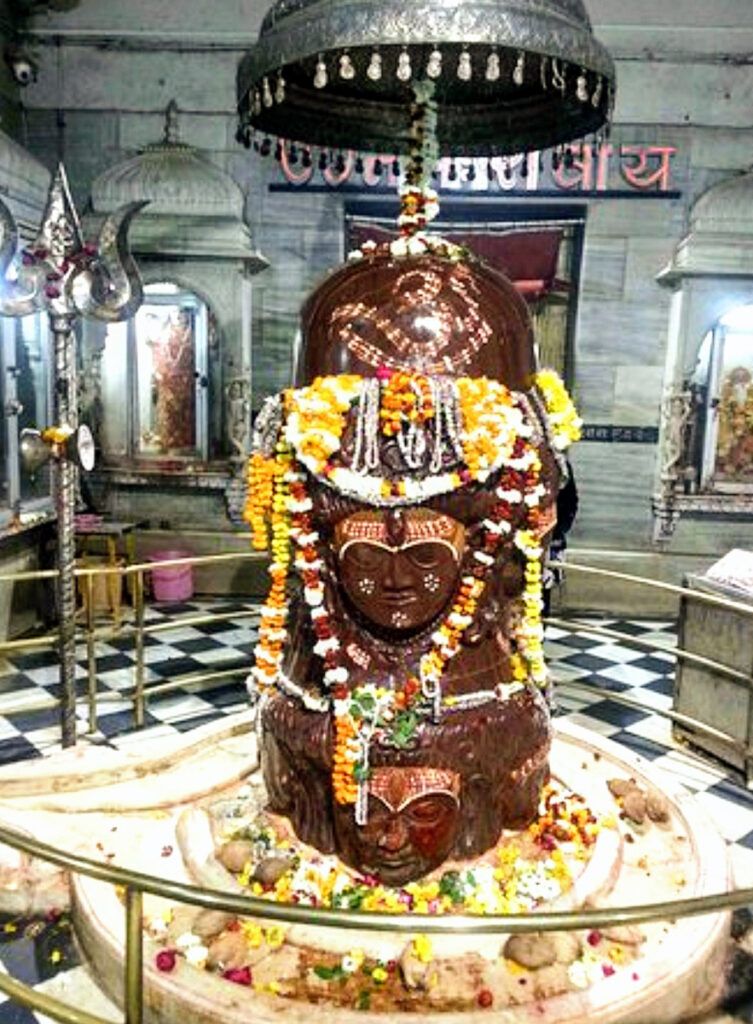
Legend of Pashupatinath Temple:
There are many legends surrounding the origins of the temple, but one of the most popular tells the story of how Shiva and his consort, Parvati, once took the form of deer and wandered through the forest on the banks of the Bagmati. The gods became angry with Shiva for neglecting his duties, and they chased him through the forest. In the ensuing fight, Shiva lost one of his antlers.
The antler fell to the ground and became a lingam, a sacred phallic symbol of Shiva. The gods were so impressed by the beauty of the lingam that they decided to build a temple around it. This temple became known as Pashupatinath, and it has been a major pilgrimage site for Hindus ever since.
Another legend tells that the Pashupatinath Temple is located on the spot where Sati Devi, the wife of Shiva, immolated herself after being humiliated by her father. Shiva was so overcome with grief that he carried Sati’s body through the universe, until he finally collapsed on the banks of the Bagmati River. Sati’s body fell apart at that spot, and one of her limbs is said to have landed on the site of the Pashupatinath Temple.
Whether or not these legends are true, there is no doubt that the Pashupatinath Temple is a holy place for Hindus all over the world. It is a place where people come to pray for forgiveness, to seek blessings, and to experience the divine presence of Shiva.
Read More>> Pancharama Kshetras: Kartikeya Breaks the Shivalinga into 5
Significance of Pashupatinath Temple:
The Pashupatinath Temple is one of the most sacred Hindu pilgrimage sites in the world. It is dedicated to Pashupati, a form of Shiva, and is located in Kathmandu, Nepal near the Bagmati River. The temple complex is vast and includes over 492 temples, ashrams, and other religious sites.
The Pashupatinath Temple is significant for a number of reasons:
- It is one of the twelve Jyotirlingas, the most sacred sites of worship for Hindus. Jyotirlingas are believed to be places where the divine light of Shiva manifests itself on Earth.
- The temple is said to be the place where Shiva and Parvati took the form of antelopes and roamed the forest. This legend is commemorated by the Pashupatinath Temple’s main shrine, which houses a lingam (a phallic symbol of Shiva) made of black stone.
- The Pashupatinath Temple is one of the four most important pilgrimage sites for Hindus in Asia. The other three sites are Varanasi, Kedarnath, and Badrinath.
- The temple is located on the banks of the Bagmati River, which is considered to be a sacred river by Hindus. Many Hindus believe that being cremated on the banks of the Bagmati River will help them achieve moksha (liberation from the cycle of birth and death).
The Pashupatinath Temple is a place of great spiritual significance for Hindus from all over the world. Devotees come to the temple to pray for forgiveness, blessings, and moksha. The temple is also a popular tourist destination, and visitors from all over the world come to marvel at its architecture and witness its unique religious rituals.
Read More>> Konark Sun Temple 13th Century Gem
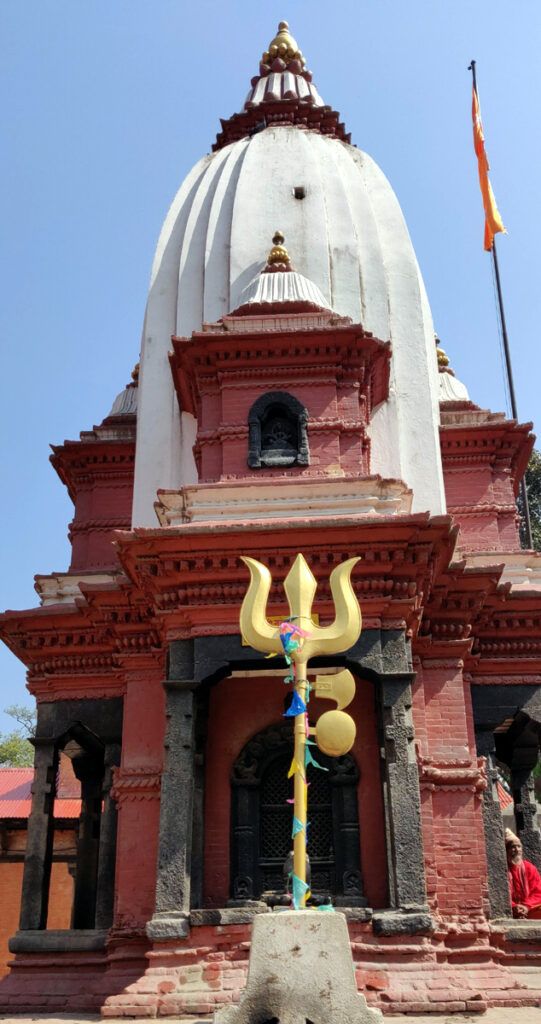
Pashupatinath Temple Timing:
- Morning Aarti: The temple typically opens early in the morning (around 4:00 AM) for devotees to attend the morning Aarti (prayer ceremony).
- Daytime Visiting Hours: The temple remains open throughout the day for visitors, and you can explore the temple premises. It’s advisable to check the specific visiting hours as they may change.
- Evening Aarti: The temple conducts an evening Aarti ceremony, and it’s a special time for devotees. The evening Aarti usually starts around 6:00 PM.
Myths of Pashupatinath Temple:
The myth of the broken horn
One of the most famous myths about the Pashupatinath Temple is the story of the broken horn. According to the myth, Shiva and Parvati once took the form of antelopes and wandered into the forest on the east bank of the Bagmati River. The other gods saw them and tried to catch them, but Shiva was able to escape by breaking off one of his horns. The broken horn was buried in the ground and became a sacred linga, which is now worshipped at the Pashupatinath Temple.
The myth of the emerging statue
Another myth about the Pashupatinath Temple is the story of the emerging statue. According to the myth, there is a statue of Lord Virupaksha buried beneath the ground in the east of the temple complex. The statue is said to be emerging slowly, and when it is fully emerged, it will signal the end of the Kali Yuga, the current dark age.
The myth of the sacred river
The Bagmati River, which flows past the Pashupatinath Temple, is also said to be sacred. According to the myth, the river is said to be the tears of Shiva, and bathing in its waters is said to cleanse one of all sins.
The myth of the crematorium
The Pashupatinath Temple complex also contains a crematorium, which is one of the busiest in Nepal. According to the myth, those who are cremated at Pashupatinath are said to be reborn into a higher caste.
Read More>> Arupadai veedu | Six Abodes of Lord Murugan
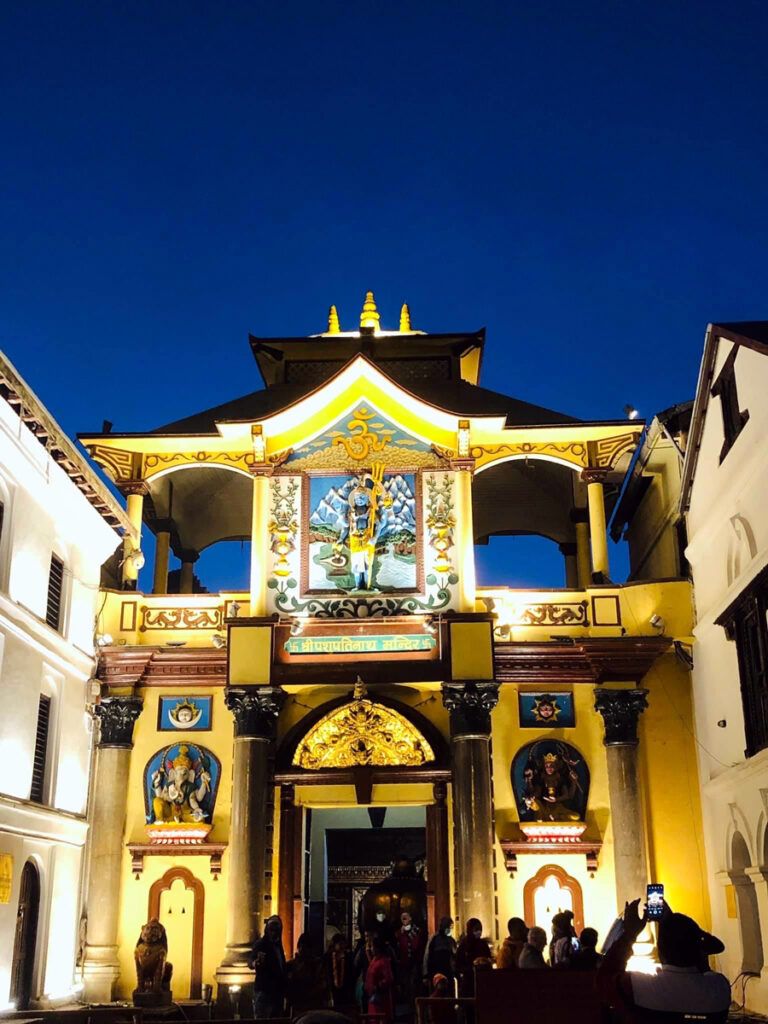
Places to visit near Pashupatinath Temple:
Boudhanath Stupa: This is one of the largest stupas in Nepal and a significant pilgrimage site for Buddhists. It’s known for its massive mandala and the peaceful ambiance. Boudhanath is just a short drive from Pashupatinath Temple.
Swayambhunath (Monkey Temple): Also known as the Monkey Temple, Swayambhunath is another iconic stupa in Kathmandu. It’s perched atop a hill and offers panoramic views of the city. It’s a short distance from Pashupatinath.
Kathmandu Durbar Square: Located in the heart of Kathmandu, this historic square is home to several ancient palaces, temples, and courtyards. It’s a UNESCO World Heritage Site and offers a glimpse of Nepal’s rich architectural and cultural heritage.
Patan Durbar Square: Located in the city of Lalitpur, just south of Kathmandu, this is another UNESCO World Heritage Site. It’s known for its well-preserved Newar architecture and artistic heritage.
Thamel: If you’re interested in shopping, dining, and nightlife, Thamel is the tourist hub of Kathmandu. It’s a vibrant area with numerous shops, restaurants, bars, and cultural activities.
Garden of Dreams: This beautiful neoclassical garden is a tranquil oasis in the heart of Kathmandu. It’s a perfect place to relax and escape the hustle and bustle of the city.
Hanuman Dhoka: It’s an ancient palace and one of the historic landmarks in Kathmandu. You can explore the courtyards and architecture of this palace.
Narayanhiti Palace Museum: This former royal palace has been converted into a museum that showcases the history and culture of Nepal’s royal family.
Guhyeshwari Temple: Located near Pashupatinath, this temple is dedicated to the goddess Guhyeshwari and is considered one of the Shakti Peethas.
Rani Pokhari: A historic artificial pond located in the heart of Kathmandu, offering a serene place for a leisurely walk.
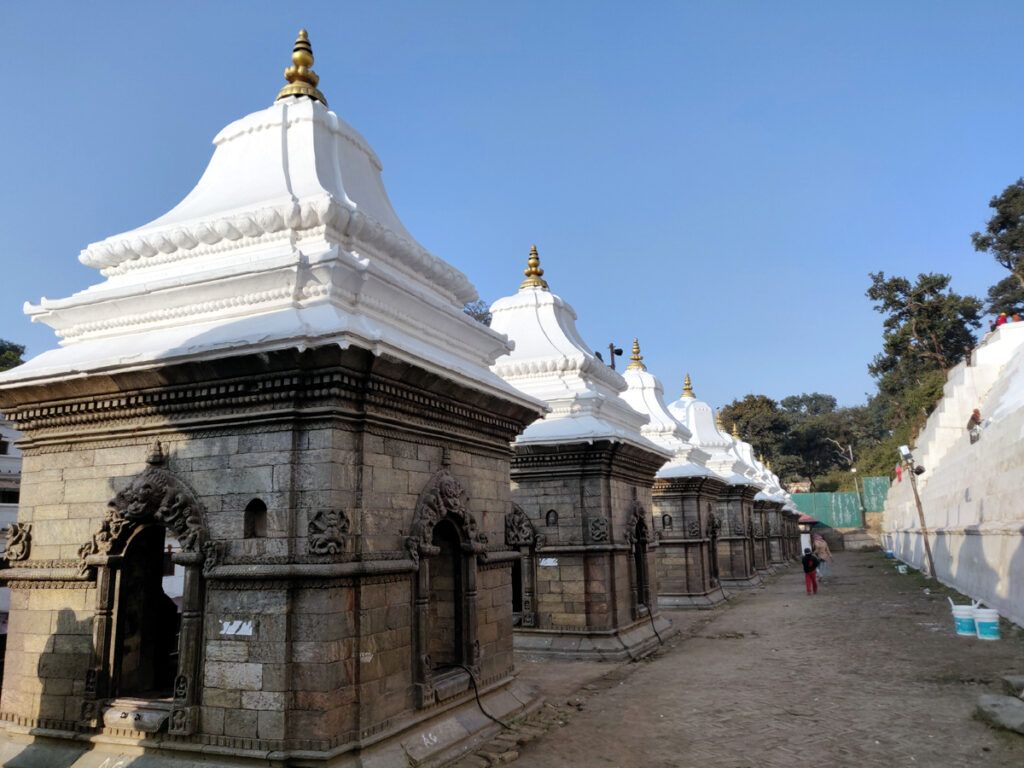
FAQ:
Q: When is the best time to visit Pashupatinath Temple?
A: The best time to visit Pashupatinath Temple is early in the morning or late in the evening. The temple complex is less crowded at these times, and you can enjoy the peace and tranquility of the place.
Q: What should I wear to visit Pashupatinath Temple?
A: It is important to dress respectfully when visiting Pashupatinath Temple. This means covering your shoulders and knees. You should also avoid wearing revealing clothing or clothing that is too tight.
Q: Can I take pictures inside Pashupatinath Temple?
A: Photography is not allowed inside the main temple building. However, you are allowed to take pictures of the exterior of the temple and the surrounding area.
Q: Can I enter the main temple building?
A: Only Hindus are allowed to enter the main temple building. Non-Hindus can visit the temple complex and view the temple from the outside.
Q: What are the rules for entering the Pashupatinath Temple complex?
A: There are a few rules that you must follow when entering the Pashupatinath Temple complex:
- You must remove your shoes before entering the temple complex.
- You must dress respectfully.
- You must avoid smoking and drinking alcohol.
- You must be respectful of the other visitors to the temple complex.
Q: What are some of the things to see and do at Pashupatinath Temple?
A: Pashupatinath Temple is a complex of temples, shrines, and other religious buildings. Some of the most notable sights include:
- The main temple building, which is dedicated to Lord Shiva.
- The Pashupatinath Ghat, which is a sacred riverside ghat where Hindus cremate their dead.
- The Mul Chowk, which is a large square in the center of the temple complex where many religious ceremonies take place.
- The Pashupatinath Museum, which houses a collection of artifacts related to the temple and its history.
Q: How can I get to Pashupatinath Temple?
A: Pashupatinath Temple is located on the banks of the Bagmati River, about 5 kilometers northeast of Kathmandu city center. You can get to the temple by taxi, bus, or private car.
Q: What are the opening hours of Pashupatinath Temple?
A: Pashupatinath Temple is open from 4:00 AM to 9:00 PM every day. However, the main temple building is closed to non-Hindus between noon and 5:00 PM.
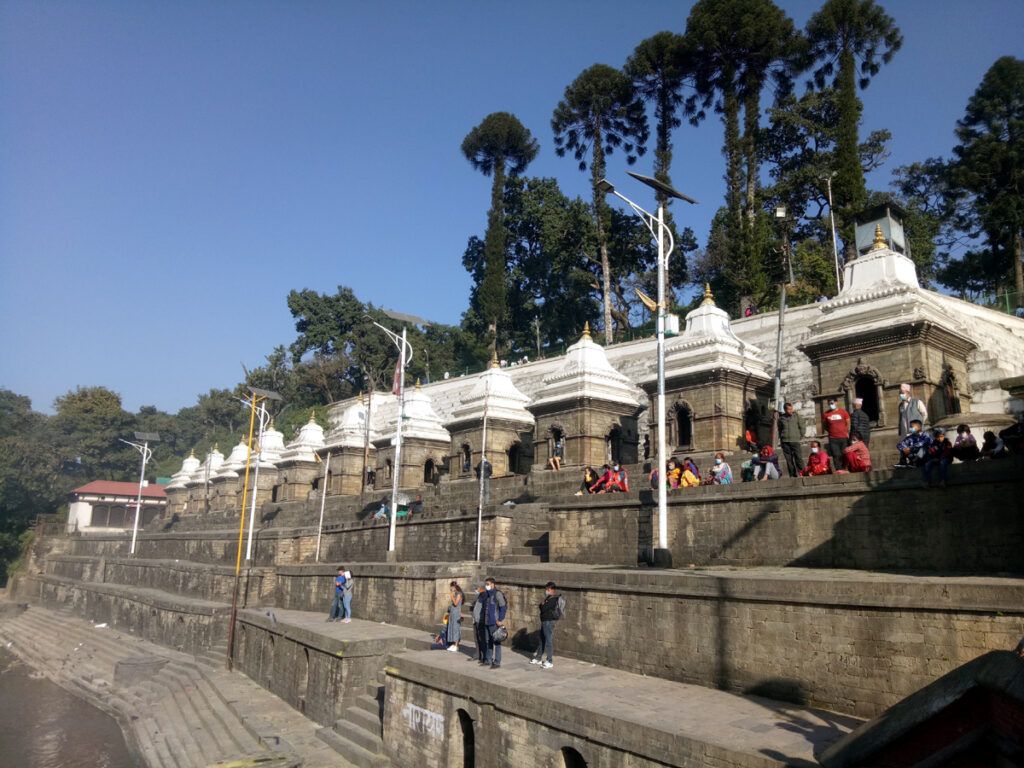
How to reach Pashupatinath Temple:
Pashupatinath Temple is a renowned Hindu temple located in Kathmandu, Nepal. To reach Pashupatinath Temple, you can follow these steps:
Arrival in Kathmandu: If you are coming from outside of Kathmandu, you’ll first need to arrive in the city. The most common way to reach Kathmandu is by air through Tribhuvan International Airport (TIA), the only international airport in Nepal.
Local Transportation: Once you’re in Kathmandu, you can use local transportation to get to Pashupatinath Temple. Here are some options:
a. Taxi: You can hire a taxi to take you to Pashupatinath Temple. Make sure to agree on the fare with the taxi driver before starting the journey, or ask them to use the meter.
b. Public Bus: You can also take a public bus to reach the temple. There are various bus routes in Kathmandu, and you might need to transfer between buses. Ask locals or at your accommodation for guidance on which bus routes to take.
c. Rickshaw: If you’re traveling within a short distance from the temple, you can use a cycle rickshaw to get there. This is a fun and eco-friendly option for short trips.
Walking: If you’re staying in the Thamel area of Kathmandu, you can even walk to Pashupatinath Temple. It’s about a 30-40 minute walk from Thamel.
Pashupatinath Temple’s Location: The temple is situated on the eastern outskirts of Kathmandu, near the Bagmati River. It’s approximately 3-4 kilometers from the city center.
Entrance Fee: There’s an entrance fee for foreigners to enter the temple premises. Make sure to have the required amount in local currency (Nepalese Rupees) to pay for the entrance fee.
Visiting Hours: Pashupatinath Temple is open to visitors during specific hours. It’s best to check the current visiting hours before planning your visit as they can change seasonally.
Respect Local Customs: Remember that Pashupatinath Temple is a sacred site, and it’s essential to dress modestly and show respect for local customs and traditions. Non-Hindus are not allowed inside the main temple building but can explore the temple complex and enjoy its cultural and architectural beauty.
It’s advisable to consult a local map or ask for directions from your accommodation to ensure you find the temple easily. Additionally, consider visiting during a non-peak time if you prefer a quieter and more contemplative experience at this significant religious site.

2 Comments